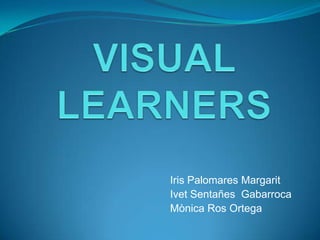
Visual learners
- 1. Iris Palomares Margarit Ivet Sentañes Gabarroca Mònica Ros Ortega
- 2. “Style” The term “style” refers to each person who learns in a different way, using different strategies even though they have the same motivations as the other learning styles.
- 3. LEARNING STYLES VISUAL learners make up approximately 65 percent of the population. AUDITORY learners represent only 30 percent of the population. KINESTHETIC learners represent the remaining 5 percent of the population
- 4. VISUAL LEARNERS “AN IMAGE IS BETTER THAN THOUSAND WORDS! “
- 5. Characteristics Visual learners often think in: • Pictures • Diagrams • Displays • Handouts • Flip-charts
- 6. Visual Students They learn much better when they read or seen the information. For an instance: In a conference they have preference to read the photocopies or other kind of guide before an oral explanation.
- 7. Advantages and disadvantages Advantatges Disadvantatges Supplement verbal instructions Information presented in the form of with an additional handout or a lecture or through verbal diagram discussion. Demonstrations that show the Excessive background noise can learner how to complete a required quickly distract. task or assignment. Incorporate colorful and tangible An assigned task without specific learning activities that include the instructions can be stressful and use of flashcards, puzzles or confusing. posters.
- 8. Quotidian actions: • I try to visualize the word in my mind. • It’s difficult to follow a long conversation. • I usually use words like: look, imagine, etc. • I prefer visual than oral presentations. It is easier to understand with images, diagrams, time lines, etc. • I like reading descriptive paragraphs because I can imagine the action.
- 9. How can visual learners help themselves? Try to find diagrams, schematics, photographs or any other visual representation. Ask to your lecture, consult reference books, and see if any CD-ROM or video of the course material are available. Prepare a concept map by listing key points, enclosing them in boxes or circles, and drawing lines with arrows between concepts to show connections. Color your notes with a highlighter.
- 10. PERSONAL OPINION Do this power point, search information and select the most important points has become a nice way to know what kind of learners we are and what can do to improve our skills while we are studying.